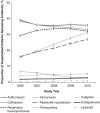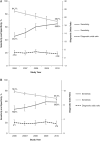Trends in Antibiotic Use and Nosocomial Pathogens in Hospitalized Veterans With Pneumonia at 128 Medical Centers, 2006-2010
- PMID: 26223995
- PMCID: PMC4599396
- DOI: 10.1093/cid/civ629
Trends in Antibiotic Use and Nosocomial Pathogens in Hospitalized Veterans With Pneumonia at 128 Medical Centers, 2006-2010
Abstract
Background: In 2005, pneumonia practice guidelines recommended broad-spectrum antibiotics for patients with risk factors for nosocomial pathogens. The impact of these recommendations on the ability of providers to match treatment with nosocomial pathogens is unknown.
Methods: Among hospitalizations with a principal diagnosis of pneumonia at 128 Department of Veterans Affairs medical centers from 2006 through 2010, we measured annual trends in antibiotic selection; initial blood or respiratory cultures positive for methicillin-resistant Staphylococcus aureus (MRSA), Pseudomonas aeruginosa, and Acinetobacter species; and alignment between antibiotic coverage and culture results for MRSA and P. aeruginosa, calculating sensitivity, specificity, and diagnostic odds ratio using a 2 × 2 contingency table.
Results: In 95 511 hospitalizations for pneumonia, initial use of vancomycin increased from 16% in 2006 to 31% in 2010, and piperacillin-tazobactam increased from 16% to 27%, and there was a decrease in both ceftriaxone (from 39% to 33%) and azithromycin (change from 39% to 36%) (P < .001 for all). The proportion of hospitalizations with cultures positive for MRSA decreased (from 2.5% to 2.0%; P < .001); no change was seen for P. aeruginosa (1.9% to 2.0%; P = .14) or Acinetobacter spp. (0.2% to 0.2%; P = .17). For both MRSA and P. aeruginosa, sensitivity increased (from 46% to 65% and 54% to 63%, respectively; P < .001) and specificity decreased (from 85% to 69% and 76% to 68%; P < .001), with no significant changes in diagnostic odds ratio (decreases from 4.6 to 4.1 [P = .57] and 3.7 to 3.2 [P = .95], respectively).
Conclusions: Between 2006 and 2010, we found a substantial increase in the use of broad-spectrum antibiotics for pneumonia despite no increase in nosocomial pathogens. The ability of providers to accurately match antibiotic coverage to nosocomial pathogens remains low.
Keywords: HCAP; antibiotic use; drug-resistant pneumonia; nosocomial pathogens; pneumonia.
Published by Oxford University Press on behalf of the Infectious Diseases Society of America 2015. This work is written by (a) US Government employee(s) and is in the public domain in the US.
Figures





Comment in
-
Editorial Commentary: The Mismatch Between Physicians' Expectations and Microbiologic Reality.Clin Infect Dis. 2015 Nov 1;61(9):1411-2. doi: 10.1093/cid/civ632. Epub 2015 Jul 29. Clin Infect Dis. 2015. PMID: 26223996 No abstract available.
References
-
- Centers for Disease Control and Prevention. Pneumonia. Available at: http://www.cdc.gov/nchs/fastats/pneumonia.htm Accessed 15 September 2014.
-
- American Thoracic Society/Infectious Diseases Society of America. Guidelines for the management of adults with hospital-acquired, ventilator-associated, and healthcare-associated pneumonia. Am J Respir Crit Care Med 2005; 171:388–416. - PubMed
-
- Mandell LA, Wunderink RG, Anzueto A et al. . Infectious Diseases Society of America/American Thoracic Society, Infectious Diseases Society of America/American Thoracic Society consensus guidelines on the management of community-acquired pneumonia in adults. Clin Infect Dis 2007; 44(suppl 2):S27–72. - PMC - PubMed
-
- Facts about ORYX for hospitals (national hospital quality measures). The Joint Commission. Available at: https://www.cms.gov/Medicare/Quality-Initiatives-Patient-Assessment-Inst.... Accessed 11 August 2015.
Publication types
MeSH terms
Substances
Grants and funding
LinkOut - more resources
Full Text Sources
Other Literature Sources
Medical
Miscellaneous

